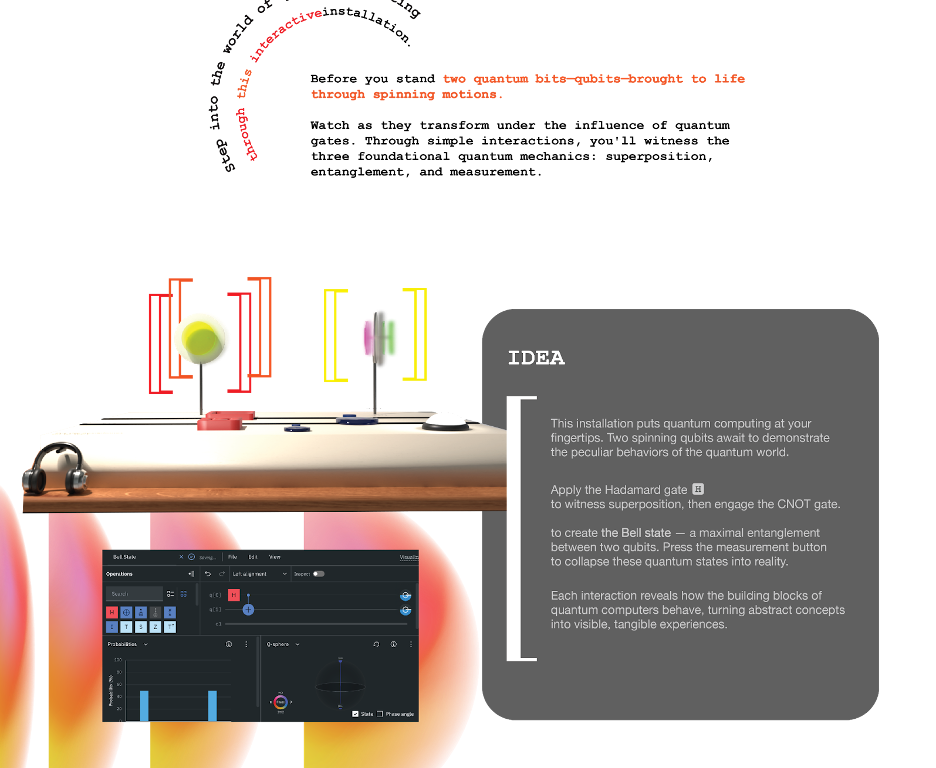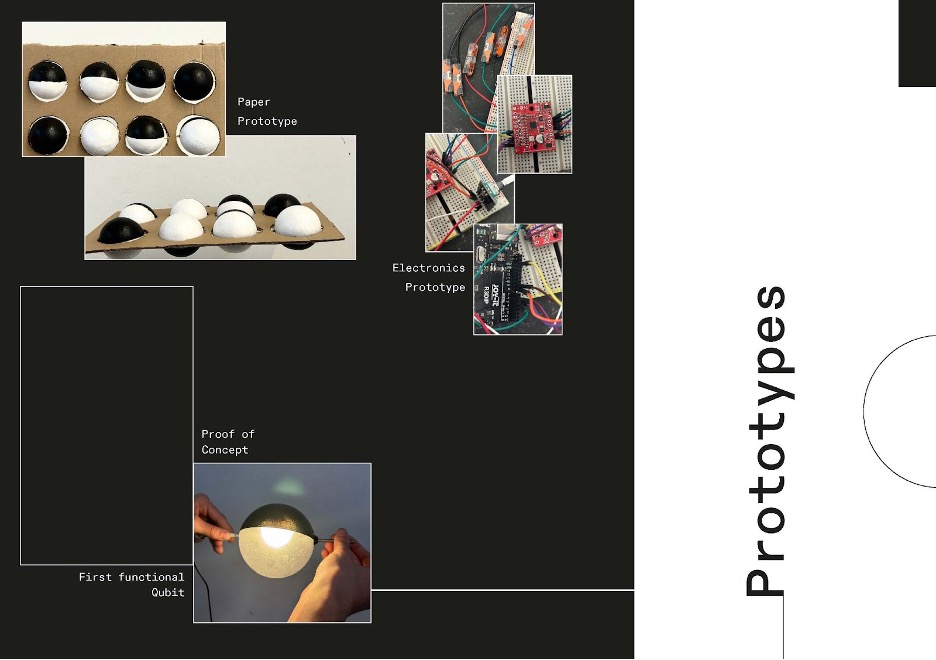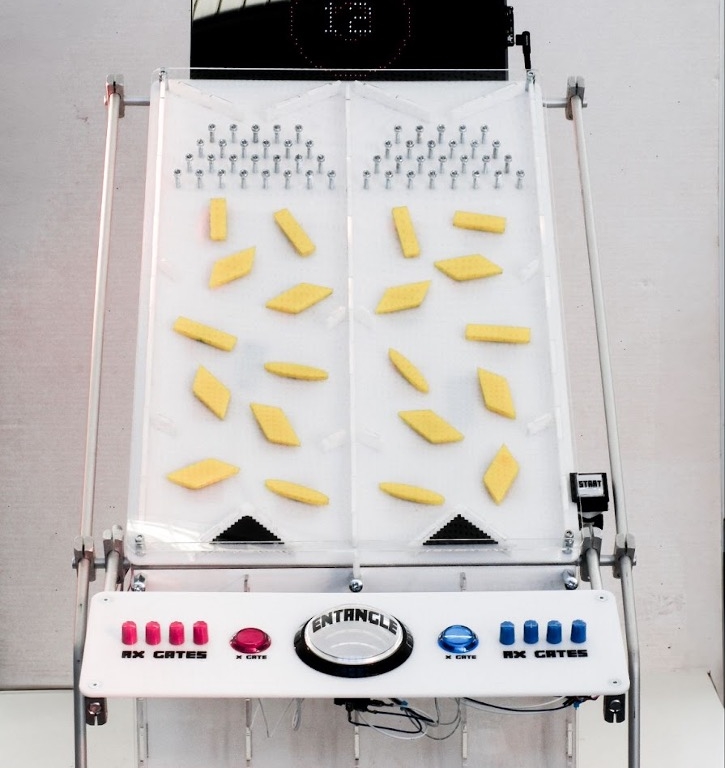In a teaching and research project, the Köln International School of Design (Cologne, Germany) and the Parsons School of Design, Design and Technology Program (NYC, USA) collaborated with the DLR Institute for AI Safety and Security (Department of Quantum AI and Quantum-classical Hybrid Systems) to develop concepts of interactive installations that help understand the weirdness of the quantum computing world.
After visiting New York in October, both schools visit Amsterdam to work at the Waag FutureLab and for a one-day symposium at the Sandberg Institute of Gerrit Rietveld Academie. Parsons School of Design, Köln International School of Design (KISD), and the German Aerospace Center (DLR) work together to communicate quantum computing through art and design. This collaboration deals with science communication and aims to creatively show quantum computing in a way that is accessible and exciting to engage with through physical interactions and materials.
How can art and design communicate the abstract concepts of quantum computing to a larger audience?
After 8 weeks of team collaboration, research & development, inputs, feedback sessions, iterations and two city trips, it was time to bring it all together in Cologne in the workspaces of Köln International School of Design (KISD).
As the whole project was following a competitive character, on the 29th November at KISD, 5 mixed student teams presented their final science communication ideas, concepts and quantum conversation pieces in form of a functional interactive prototype to a jury consisting of a neutral audience of the DLR, Sonja Eikenberg and Krzysztof Bieniasz, who were not direct part of the project yet, and Dr. Hans-Martin Rieser, who served in the role of a “client”.
From aesthetically driven design approaches, translating qubits and the world of quantum computing into metaphors of light pulses in “Fleeting States & Measuring Values”, to a demonstration of the differences between classical computing and quantum computing through two flipping and rotating wall-objects in “[Beyond]Binary”, to an audio-guided installation explaining calculating quantum circuits with gates as haptic objects in “States & Gates”, all teams succeeded the project with physical representations and interactive experiences. Marbility proposed an educational two-player game, showing dynamics between quantum gates, entanglement, and probability in a fun and accessible way while “Quantum Abacus” convinced with its strong visuality and mechanical demonstration of the quantum wave function collapse. Just like a traditional abacus, the kinetic installation explores physically performing a calculation. But rather than performing a deterministic calculation, it visualizes the probabilistic nature of quantum computation.
Based on the criteria, the DLR jury statement sounded as follows announcing the winning team “Quantum Abacus” by Milan Elsen, Cora Kindermann, Ashley Lee, Sofia Pristash, Sirui Liao, Zhuoyu Zhang:
“The jury decision between all of these very appealing approaches has not been an easy one. For us, the „Quantum Abacus” combines several key points with respect to the goal of providing a quantum computing exhibit for DLR. First, it features an aesthetic that integrates well into DLR’s communication style. Second, the accessible haptic approach to complex scientific topics engages visitors to experiment with the object. Third, the implementation convinced the jury of the practicality and sturdyness necessary for a public exhibit off-site.”
The winner team Quantum Abacus is getting the chance to realize their prototype in the work environment of DLR. It will be produced in the upcoming year and exhibited in the context of https://quantum2025.org.
Project site: https://howtoshowoffquantumcomputing.cargo.site

_______________________________________________________________
About “Quantum Abacus” – winning project by Milan Elsen, Cora Kindermann, Ashley Lee, Sofia Pristash, Sirui Liao, Zhuoyu Zhang
The interactive exhibit “Quantum Abacus” illustrates the abstract scientific concepts of quantum superposition, the observer effect and the application of quantum gates.
Just like a traditional abacus, the kinetic installation explores physically performing a calculation. But rather than performing a deterministic calculation, it visualizes the probabilistic nature of quantum computation.
Qubits are visually represented as a set of rotating spheres, that visually and mechanically perform the computation. They display a certain amount of dark and light. This represents superposition, with the amount visible being the probability of measuring either state.
Visitors can manually rotate the spheres, this interaction visualizes how quantum gates manipulate the quantum state of each qubit. Altering the amount of light or dark allows the visitor to physically control the measurement probability. This reflects the aspects of superposition and gate application. The haptic interaction allows for a memorable experience.
A display guides through the interaction, providing instructions and additional information. When visitors get to the measurement function and press the button to activate it, the true quantum nature becomes apparent. Motors rotate the spheres to their final position of either pure dark or pure light.
This final state is randomly determined based on the probability distribution at the moment of measurement, physically demonstrating the quantum wave function collapse. For a deeper understanding, multiple plays are suggested.
https://howtoshowoffquantumcomputing.cargo.site/quantum-abacus

_________________________________________________________________
Project Team
Studentteams KISD x PARSONS: Till Beyer, Sofia Fellinger, Seth Lukin, Colby Lamson-Gordon, Ziye An, Rishikaa Modi (Marbility)/ Leon Scheuemann, Nele Obenbiermann, Christine Chang, Kritchaporn Kulrattanarak, Sara A. Celidonio, Liwenyi Zhang (Gates & States) / Paul Abends, Lilith Meyer, Bini Park, Lorraine Cruz, Divija Diwan, Miao Lan Zhang ([Beyond]Binary)/ Milan Elsen, Cora Kindermann, Ashley Lee, Sofia Pristash, Sirui Liao, Zhuoyu Zhang (Quantum Abacus)/ Aikaterini Sideri, Jana Hartmann, Prakhar Mittal, Paridhi Garg, Mika Arai, Yue Hu (Fleeting States & Measured Values)
Faculty: Prof. Nina Juric, Prof. Lasse Scherffig and Julius Walsch / Köln International School of Design, TH Köln with 10 students
Sven Travis, Michie Pagulayan and Brad MacDonald / Parsons School of Design, Design and Technology program, New York with 20 students
In collaboration with
Prof. Dr. Frank Köster, Dr. Markus Lange, Dr. Hans-Martin Rieser with support of Andrew Barlow and Cristobal Corvalan Morbiducci/ / DLR Institute for AI Safety and Security, Department of Quantum AI and Quantum-classical Hybrid Systems, Sankt Augustin and jury help from Sonja Eikenberg and Krzysztof Bieniasz
_____________________________
Further projects:
Marbility – A playful introduction to quantum gates, qubits, entanglement & probability
by Till Beyer, Sofia Fellinger, Seth Lukin, Colby Lamson-Gordon, Ziye An, Rishikaa Modi
How can we engage people with little or no knowledge of quantum computing and quantum physics? How can we show dynamics between quantum gates, entanglement, and probability in a fun and accessible way? Marblebility is an educational and entertaining game to introduce quantum computing to a broader audience. How do we do this? In the game, you and your teammate each control a qubit and try to score the correct probability given to you. You interact with gates and learn about probability and entanglement. With the aesthetics of Pinball and Plinko–widely-known, nostalgic games that are easy to understand–we attract people of all ages and backgrounds.
Concept:
People learn new concepts better when they can connect new ideas to familiar ones. It is also easier for people to engage with complex subjects if they can learn in a fun and accessible way. So, we decided to create a project that introduces quantum computing, a complex topic, through a fun game (inspired by Plinko and Pinball machines). By using visual elements from both of these games, we appeal to a wider audience because it looks familiar, is fun, and has a nostalgic feel. Because this gameplay is well-known, it is very intuitive to play: you see the task on the scoreboard, you have buttons that react to being pushed, and you learn rules of entanglement through exploratory play.
From a quantum perspective, our game highlights how quantum gates influence a quantum circuit and its end distribution. A large button for entanglement creates a new entanglement configuration when pressed, while knobs move levers, aka gates, that change the flow of the marbles. These marbles are “shots;” hypothetically after N number of trials–or rounds of gameplay–one would see a normal distribution. While players work together to aim for a probability together, they press buttons and see in real-time entanglement, as levers on the gameboard twist 180 degrees in entangled groupings. In sum, our project allows people to understand entanglement in quantum circuits and its distribution at the end in a hands-on way.
This interactive exhibit introduces the audience to quantum concepts of entanglement, gates, probability, and qubits through an interactive game. Inspired by old arcade games such as Plinko and Pinball.
https://howtoshowoffquantumcomputing.cargo.site/marbility
______________________________________________________________
[Beyond]Binary – quantum loading… How does quantum computing differ from classical computing?
by Paul Abends, Lilith Meyer, Bini Park, Lorraine Cruz, Divija Diwan, Miao Lan Zhang
Our project [Beyond] Binary visualizes the operative process of a quantum computer by contrasting it with classical computation. Two interactive displays of spinning rectangular tiles represent each system with its respective smallest building blocks: Bits and QBits. By leveraging the familiarity of classical computing, we want to make the abstract concept of quantum computing more accessible.
The idea is to demonstrate the operative functions and distinct characteristics of QBits (quantum bits) in parallel computing by displaying a grid of moving tiles, white on one side and black on the other, and comparing it to an identical setup, which represents the classical computing process.
The different states each display showcases are simultaneously announced by two voiceovers to provide context as well as highlight how the two processes differ but can exist alongside each other.
https://howtoshowoffquantumcomputing.cargo.site/(beyond)binary
_________________________________________________________________
Fleeting States & Measured Values – The two worlds of quantum computing
by Aikaterini Sideri, Jana Hartmann, Prakhar Mittal, Paridhi Garg, Mika Arai, Yue Hu
How can we show the invisible is a common question in science communication. Science can operate on a level so small it is inconceivable by the human eye or it can investigate more abstract topics like human interaction.
Our approach to explaining quantum computing is a two-world concept. We show the invisible aspects of quantum computing as well as the visible. The separation of the worlds is analytical. It serves to show two sides of quantum computing. On the one hand, we have the values we can measure, probabilistic results in units. It is how we are trained/used to interact with phenomena. Superposition and entanglement on the other hand are neither accessible to our senses nor measurement.
In the world of fleeting states, we show a set of qubits that react to interactions with the interface. On the interface users can operate gates to manipulate the q-bits. While these changes are immediately observable in the hidden world, on the interface they can only be seen as a statistical probability and only after measuring. Users can playfully gain insights on quantum principles, just by exploring the interface.
https://howtoshowoffquantumcomputing.cargo.site/fleeting-states-+-measured-values



 _________________________________________________________________
_________________________________________________________________
[gates and states]
by Leon Scheuemann, Nele Obenbiermann, Christine Chang, Kritchaporn Kulrattanarak, Sara A. Celidonio, Liwenyi Zhang
[gates and states] is an interactive installation that shows off quantum computing through engaging storytelling. Based on IBM’s Quantum Composer interface, visitors can explore quantum concepts through their preferred narrative style – whether technical, mystery, or conversational. By transforming complex scientific principles into tangible, hands-on experiences, this audio-guided journey makes quantum computing accessible to visitors from all backgrounds.
https://howtoshowoffquantumcomputing.cargo.site/[gates-states]
____________________________________________________________________














































